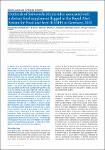Outbreak of Salmonella Montevideo associated with a dietary food supplement flagged in the Rapid Alert System for Food and Feed (RASFF) in Germany, 2010
Stöcker, Petra
Rosner, Bettina
Werber, Dirk
Kirchner, Markus
Reinecke, Annette
Wichmann-Schauer, Heidi
Prager, Rita
Rabsch, Wolfgang
Frank, Christina
In March 2010 the Rapid Alert System for Food and Feed (RASFF) was used to inform about Salmonella Montevideo in a herbal food supplement, formulated in capsules, distributed under a Dutch label in Germany. Simultaneous to the first RASFF notice, in the last two weeks of March 2010 an unusual number of 15 infections with S. Montevideo was notified within the electronic reporting system for infectious diseases at the Robert Koch Institute. Adult women (median age: 43, range: 1–90 years) were mainly affected. An outbreak was suspected and the food supplement hypothesised to be its vehicle. Cases were notified from six federal states throughout Germany, which required efficient coordination of information and activities. A case–control study (n=55) among adult women showed an association between consumption of the specific food supplement and the disease (odds ratio (OR): 27.5, 95% confidence interval (CI): 3.1–infinity, p-value=0.002). Restricting the case–control study to the period when the outbreak peaked (between 29 March and 11 April 2010) resulted in an OR of 43.5 (95% CI: 4.8–infinity, p-value=0.001). Trace-back of the supplement’s main ingredient, hemp seed flour, and subsequent microbiological testing by pulsed-field gel electrophoresis supported its likely role in transmission. This outbreak investigation illustrates that information from RASFF may aid in hypothesis generation in outbreak investigations, though likely late in the outbreak.
No license information

